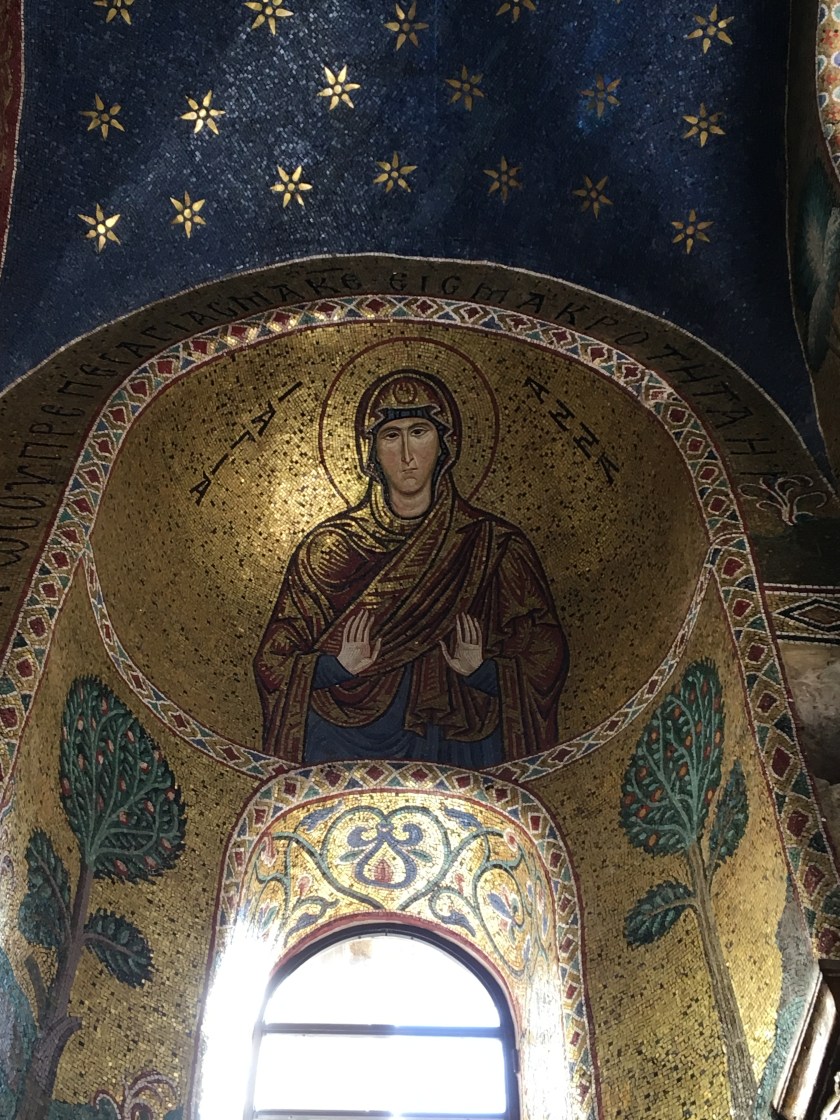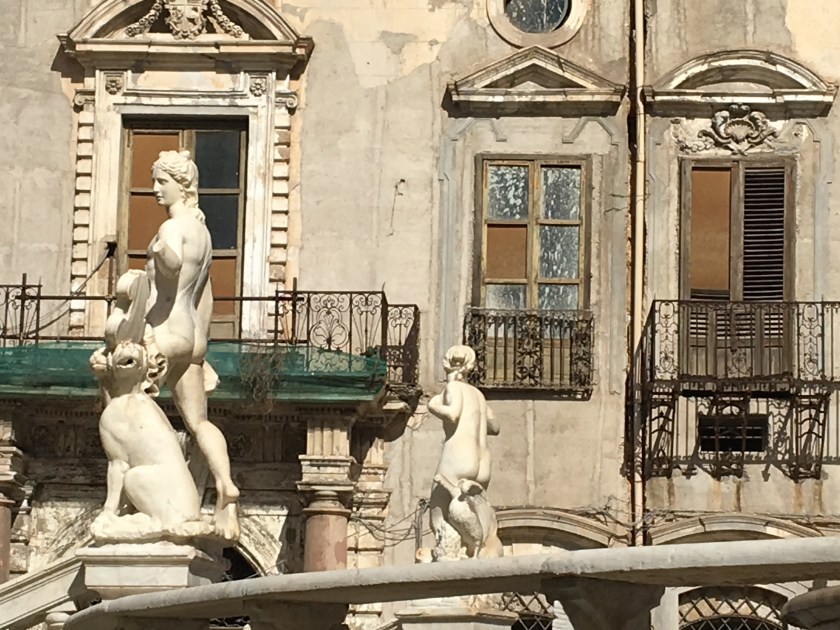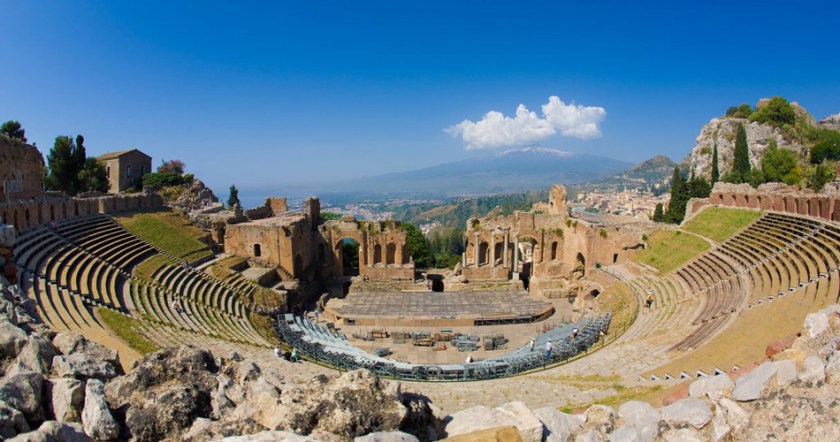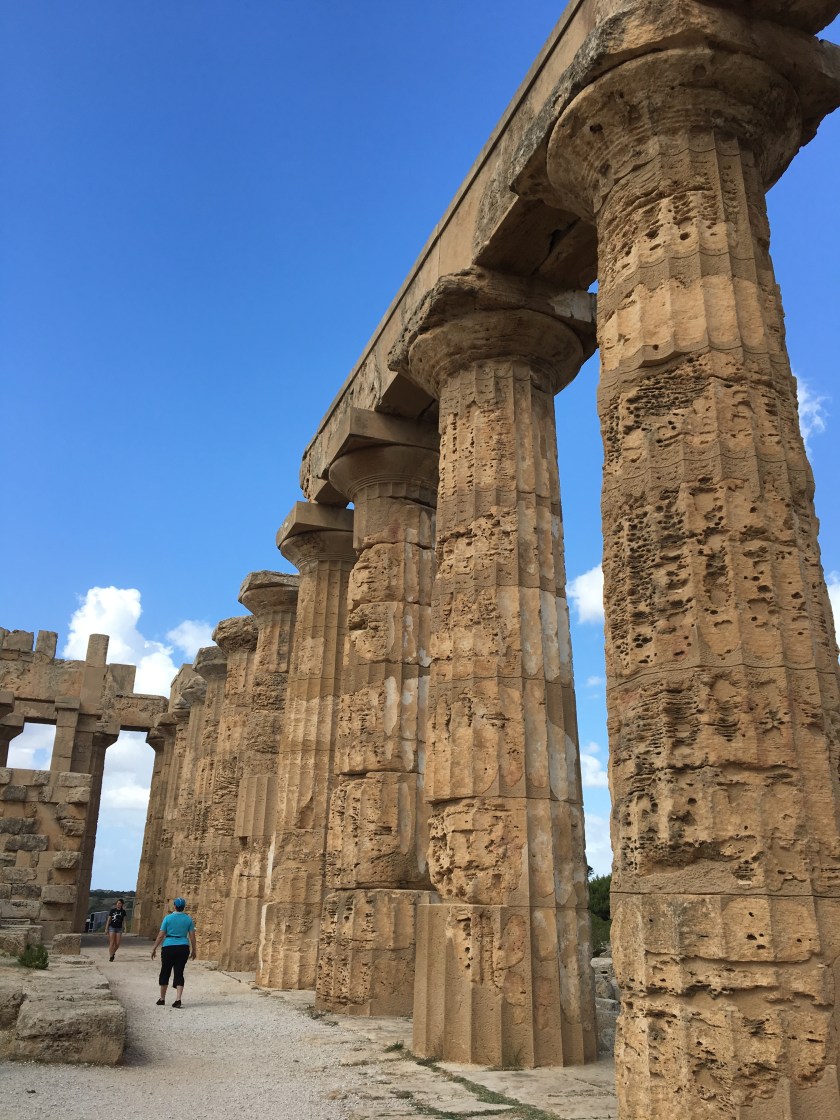
The Ancient Greeks left their mark everywhere – everywhere in the known world, or Oecumene, a Greek geographical concept describing the inhabited parts of the world. They were merchants and traders, and they were the first to colonize Southern Italy, where they founded Magna Graecia, which included the island of Sicily. They first started living there in the 8th and 7th centuries BC and, since then, Sicily has seen the passing of many civilisations, the remnants of which form rich layers in the tapestry of the island. Greek, Roman, Byzantine, Arabic – they are intertwined in many ways.

In Palermo, a city which teems with the same variety of faces one probably came across all these centuries ago, driving is a hazardous affair. In the old town, the streets are so narrow that even a small car brushes the houses on either side, where open doors reveal the trappings of daily life – a woman ironing, a baby in a high chair – while tourists walk in the middle of the road gawping at the sights, and scooters edge past without slowing down at all. There are no sidewalks, and road signs are cheerfully ignored by all and sundry.

In the Piazza Bellini (above), three Churches surround a paved square.
San Cataldo, an austere Norman structure made of grey stone (seen on the right), and Santa Margarita del Amiraglio, (on the left) whose enchanting interior combines astonishing Byzantine mosaics with an elaborate baroque centre.

The mosaics are literally breathtaking.

Below is a view of the dome with mosaic of the Pantokrator.

The byzantines did like their gold!

And the decorative details are also beautiful.

Through the window can be glimpsed the façade of the third church, Santa Caterina, on the opposite side of the square. Its interior is a synthesis of Sicilian baroque, Rococo and Renaissance.

Behind Santa Caterina, Piazza Pretoria boasts a fountain which, while it is not Greek, I could not resist photographing, since it is decorated with a series of marvelous carved animals, all different and sporting exquisite expressions on their white marble faces.

The Petoria Fountain was built in Florence, but was sold to Palermo in 1554.

Due to the nudity of the statues on the top of the fountain, considered shocking at the time, the square became known as Piazza Della Vergogna, or Square of Shame.

In Taormina, the Greek Theatre was built in the 3rd century BC. An incredible 100.000 cubic meters of rock were moved for its excavation, and it could seat over 5000 people. In Roman times it was renovated and enlarged and the brickwork of that era still survives today. As with all Greek theatres it has brilliant acoustics and is regularly used every summer for opera, concerts and plays.

The view from the gods includes brilliant sunsets and the majestic cone of the Etna volcano, which is the largest on the whole Italian peninsula, and the tallest volcano in Europe. The Greeks considered Etna to be the forge of Haephaistos (Vulcan) who used it to create thunderbolts for Zeus; it was also the home of the giant one-eyed monster, Cyclops.

Syracuse (Συρακούσαι) and Selinunte (Σελινούς) were also cities founded by the Greeks, whose names were often mentioned in the reams of Ancient Greek text – Thucydides, if I’m not mistaken – which we had to translate at school, with a cheat sheet under the desk (bought at the local stationers’). All those complicated wars and sieges would have been brought to life if the school had organised a trip to Sicily for us.
In Selinunte, the temple dedicated to Hera is majestic, larger than most found in Greece.

It is difficult to imagine it painted in blue and red, as it was in antiquity.

Of the three temples on the religious site at Selinunte, this is the only one to have been partially restored.

Through the columns, one can glimpse wonderful views of the sea.

This is the smaller of the three temples on the site, the third and largest being probably dedicated to Zeus.

The columns have imploded and are tumbled in heaps, with greenery and brambles growing amongst them.

The photo below shows the sheer size of each hewn pillar.

Further from the religious site stand the remnants of the Acropolis and the old fortified city. Selinunte, whose name derives from the Greek selinon (Σέλινον) for the wild celery which grows abundantly here and whose image they used on their coins – was a thriving town comprising, at its peak, more than 30.000 inhabitants , excluding slaves. As was inevitable, they were involved a series of wars with their neighboring cities.

In 409 BC, the Segestans, with whom they had been fighting, asked for help from the Carthaginians, who were of Phoenician descent and based in Tunis. They crossed over in a fleet of 100.000 men and laid siege to the city. Finding the inhabitants unprepared for such an assault, they breached the walls, lay waste to the whole town and massacred 16,000 people. A further 5000 were taken into slavery. The survivors eventually came back but, despite various attempts to rebuild, Selinnte never regained its former status.

Trying to imagine what it must have been like, looking over that beautiful sea and seeing the Carthaginian fleet appear over the horizon.
Sicily is a large island and there are many more places to visit, such as the Valley of the Temples in Syracuse. It is home to around five million inhabitants and is a melting pot of a variety of different cultures and ethnicities, including the original Italic people, the Greeks, Romans, Byzantines, Saracens, Normans, Swabians, Aragonese, Lombards, Spaniards, French, and Albanians, each having contributed to the island’s culture and genetic makeup. It also boasts stunning scenery, great beaches, friendly and hospitable people and fantastic food.
Foodie footnote: Apart from great olive oil, honey and tomatoes, Sicilian produce includes lemons and pistachios. The refreshing lemon granita is to die for, as is the pistachio ice-cream and semi-fredo. You are offered all kinds of fresh fish and shrimp, caponata made with their delicious aubergines, food with oriental touches such as chickpea fritters and, among the endless variety of pasta, a dish I’d never tried before: linguine with lemon and pistachios – absolute heaven on a plate. And a final unmissable – the cannoli: crunchy biscuits tubes filled with whipped ricotta in many flavors (including pistachio, of course!). And, last but not least, one must not forget the delicious local wines.


Stunning! It looks like one of those photogenic places that has a photo (and a sketch?) at every turn. The mosaics are beautiful. Imagine how over-powering it must have been for believers, especially in flickering candlelight. Thanks for showing me these delights.
LikeLiked by 1 person
It was lovely. If I’d been alone I would have spent a lot of time sketching, but it’s hard if you’re not with other sketchers…
LikeLike
This is wonderful. Your photos are exceptional, and so is the history behind the photos. Thank you!
LikeLike
So glad you enjoyed it, Jennie!
LikeLiked by 1 person
😀
LikeLike
The photos are stunning! Thanks for all of the information and the gorgeous photos! Wow
LikeLike
Thank you, Lynn. I’m glad you liked them🌺
LikeLiked by 1 person
Thanks for the tour – probably the closest I’ll ever get
LikeLiked by 1 person
Well I’m glad you enjoyed it! Thanks🌺
LikeLiked by 1 person
Just wonderful Marina x
LikeLiked by 1 person
It was, Cheryl!
LikeLiked by 1 person
x
LikeLike
Such an incredible and beautiful history revealed in these photos. It’s hard to choose a favorite out of so many wonderful images but I keep being drawn to the fountain of spouting animals. What a glorious place. Thank you for the tour.
LikeLike
Glad you enjoyed it, Sharon!
LikeLike
Beautiful and thoroghly enjoyable post.
LikeLiked by 1 person
Thank you!
LikeLike
I had no idea of Sicily’s Greek heritage. Now that I know, I shall be looking out for signs of it in Montalbano. Those Byzantine church interiors are amazing.
LikeLike
They were. And the archaeological sites were breathtaking 🌺
LikeLiked by 1 person
A great trip, Marina. I have never been to Sicily but have read something of the history, and tried the red wines too!
The church interiors are stunning.
Best wishes, Pete.
LikeLike
Thank you, Pete!
LikeLiked by 1 person
Great post ! 😊
LikeLike
Thanks, Efterpi!🌺
LikeLiked by 1 person
Excellent photography and descriptive prose, especially of the streets of Palermo
LikeLiked by 1 person
Thanks, Derrick🌹
LikeLiked by 1 person
Wonderful shots and descriptions. I hadn’t realised Sicily has so much to offer.
LikeLike
Definitely worth a trip🌺
LikeLike
Thanks, Derrick🌹
LikeLike
Amazing post.. the loved the sky in all the pictures. 😍
LikeLiked by 1 person
I’m glad you enjoyed it! Thanks for dropping in 🌺
LikeLike
Wow! This is such an informative and interesting post. 🌸
LikeLiked by 1 person
Thank you! Glad you enjoyed it🌺
LikeLiked by 1 person
Your welcome!
LikeLike